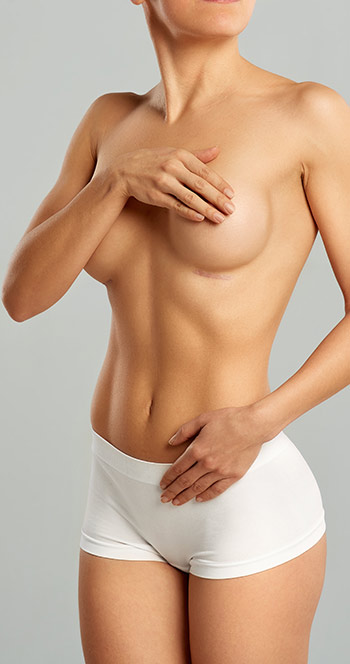
Breast augmentation surgery is among the most popular cosmetic procedures in the United States. It offers transformative results for women seeking enhanced confidence and a more proportionate figure. At SunCoast Plastic Surgery, we specialize in delivering personalized breast surgery solutions tailored to your unique aesthetic goals.
Breast implant surgery gives women with small or unevenly sized breasts a fuller, firmer, better-proportioned appearance. Breast augmentation is achieved by placing silicone or saline implants in the breast, resulting in beautiful, natural-feeling breasts that are one or more cup sizes larger. It can also easily be paired with a breast lift for additional correction. Women choose a breast implant procedure for a variety of medical and aesthetic reasons, including balancing breast size, compensating for reduced breast mass after pregnancy or surgery, or correcting a congenital breast defect. If you are interested in seeing if you are a good candidate for breast implants, a breast reduction, or implant exchange to replace old implants, Dr. Chaudhari at SunCoast Plastic Surgery in Pearland/Houston can help you achieve the aesthetic you desire.
Breast Implant Safety
Surgery & Recovery
At SunCoast Plastic Surgery, we offer a variety of implant types. Implants are silicone shells filled with either saline (salt water) or silicone gel. During breast augmentation surgery, the implants are placed behind each breast, beneath the natural breast tissue or the chest wall muscle. Both types of breast implants are completely safe, and Suncoast Plastic Surgery works diligently to reduce the risk of breast implant illness and visible scar tissue.
One primary advantage of saline breast implants is that, if ruptured, the saline (salt solution) is naturally dissolved and absorbed by the body. Another disadvantage of saline-filled implants is that they may appear less natural in small-breasted or breast reconstruction patients. This is an important consideration for very thin women with minimal breast tissue to cover the implant or women who have a breast injury or need breast reconstruction. However, there are much fewer adverse effects with saline breast implants in the event of a breast implant rupture when compared with silicone implants.
Silicone implants are popular among patients due to their soft texture and natural feel. Filled with cohesive silicone gel, these implants closely mimic the look and feel of natural breast tissue, making them an excellent option for those seeking a more authentic result. One of the key advantages of silicone implants is their ability to provide a natural appearance while minimizing the risk of rippling, resulting in a smoother, more aesthetically pleasing outcome. At SunCoast Plastic Surgery, we are proud to offer premium silicone gel-filled implants to help you confidently achieve your desired aesthetic.
Most patients prefer silicone gel implants primarily because they feel more natural. At SunCoast Plastic Surgery, we are proud to offer patients this option, as they are much softer and feel more natural than saline-filled breast implants.
The breast implant procedure, aka mammoplasty, takes one to two hours to complete and is typically performed under general anesthesia. Incisions are made in inconspicuous places on the breast to minimize scar visibility, and the best choices for incision placement are:
Underside of the Breast (Inframammary)
Areola (Periareolar)
Armpit (Transaxillary)
With each type of incision, once the incision is made, a pocket is created for the breast implant. The breast implant is then slid through the incision and centered behind the nipple.
An inframammary incision is made under the breast and close to the inframammary fold. This type of incision secures proper placement of the implant, but also reduces scar visibility. An advantage of the inframammary incision is that the surgeon works close to the breast, allowing for optimal visibility while working.
The areola is the dark skin surrounding the nipple, and a periareolar incision is placed in the transition area, between the dark areola and the lighter surrounding breast skin, where it is less visible. Like the inframammary incision, the periareolar incision allows the implant to be placed in precise pocket formation and provides for absolute controlled bleeding.
The armpit incision is reserved for saline breast implants because the implant shell can be placed and filled once it’s in the breast. This breast implant placement can be more complex and your board-certified plastic surgeon will recommend if it’s right for you.
Every woman is unique in both her natural body shape and desires for her personal appearance. With that in mind, Dr. Chaudhari works closely with each patient during the pre-operative consultation to learn the patient’s goals for breast augmentation surgery. Together, Dr. Chaudhari and the patient will decide which implant type, size, and placement is best. In this way, each patient enjoys completely customized treatment based on her specific goals.
If you’re planning a breast augmentation procedure, during your consultation, you and Dr. Chaudhari will make decisions together about the type, size, incision and placement of your implants. Your body type and anatomy impact these decisions, so Dr. Chaudhari will discuss with you all the options for breast augmentation surgery, depending on your current measurements, your body frame, and your expectations.
Dr. Chaudhari performs every procedure with great care and precision to ensure that each patient can enjoy a quick and healthy recovery. A surgical bra is typically required after surgery, and some bruising, soreness and swelling are to be expected. Patients may feel tired for a day or two following surgery, and while most patients are able to return to work within two weeks, physical activity should be avoided for longer.
Following implant insertion, you can expect some breast pain, swelling, and bruising, which are normal and typically subside within a few weeks. Your plastic surgeon may prescribe pain medication to manage any discomfort and recommend wearing a supportive surgical bra to minimize swelling and provide stability as your breasts heal.
Light activities such as walking are encouraged to promote circulation, but you’ll need to avoid strenuous activities, heavy lifting, and intense exercise for at least 4-6 weeks. Depending on the nature of their job, most patients can return to work within 1-2 weeks.
As your body continues to heal, swelling will gradually decrease, and your silicone or saline implant will settle into its final position over several months. Staying hydrated, maintaining a healthy diet, and avoiding sleeping on your stomach or sides will help support your body’s healing process.

SunCoast Plastic Surgery is dedicated to providing personalized care so you feel supported every step of the way. Schedule a consultation with SunCoast Plastic Surgery in Pearland/Houston to achieve your ideal look. Whether you’re exploring your options for breast implants, a breast lift, or an implant exchange, our team is here to help you feel confident and beautiful.
brooke burke on breast implant safety
brooke burke on breast implant options
silicone memory gel safety
brooke burke on breast enhancement post-baby
Get in touch...
©2024 Suncoast Plastic Surgery
Website design by Ad Factory Inc. Special deals graphics by Chelsea = )